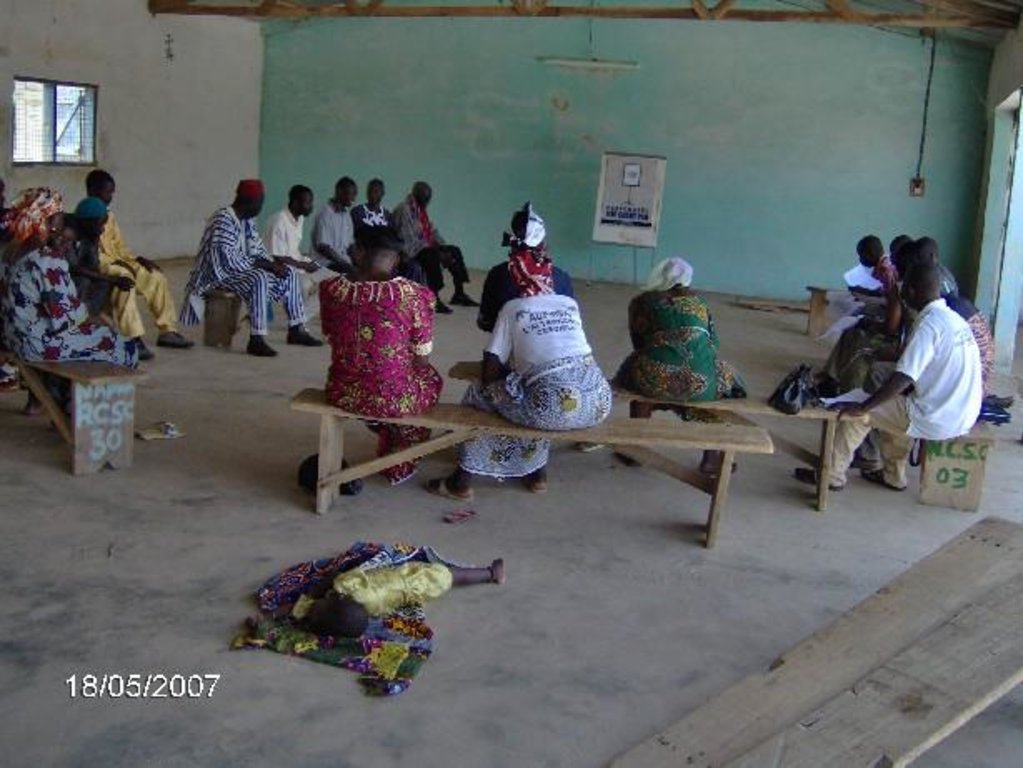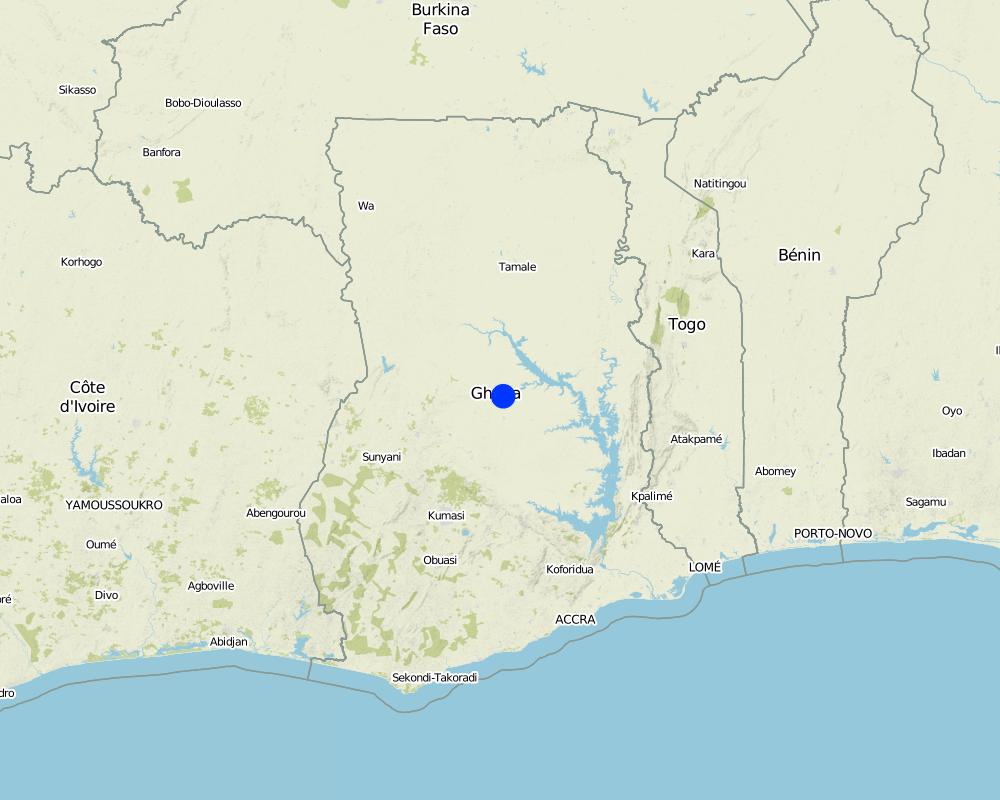Participatory Negotiated Territorial Development [加纳]
- 创建:
- 更新:
- 编制者: Philippe Zahner
- 编辑者: –
- 审查者: Fabian Ottiger
approaches_2570 - 加纳
查看章节
全部展开 全部收起1. 一般信息
1.2 参与方法评估和文件编制的资源人员和机构的联系方式
SLM专业人员:
Groppo Paolo
paolo.groppo@fao.org
FAO
Rome
意大利
SLM专业人员:
Cenerini Carolina
carolina.cenerini@fao.org
FAO
Rome
意大利
有助于对方法进行记录/评估的机构名称(如相关)
Swiss Agency for Development and Cooperation (DEZA / COSUDE / DDC / SDC) - 瑞士有助于对方法进行记录/评估的机构名称(如相关)
Food and Agriculture Organization of the United Nations (FAO) - 意大利1.3 关于使用通过WOCAT记录的数据的条件
编制者和关键资源人员接受有关使用通过WOCAT记录数据的条件。:
是
2. SLM方法的描述
2.1 该方法的简要说明
Participatory Negotiated Territorial Development (PNTD) is a rural development approach developed by FAO.
2.2 该方法的详细说明
该方法的详细说明:
Aims / objectives: It offers a structure to build consensus among individual communities and development partners on natural resources/territorial management and development issues. PNTD facilitates consensus based planning within a team that represents different actors at different levels, including sector offices / technical services (agriculture, environment, etc.) and NGOs (involved in community-based rural development) at district/ department/ municipality level; and traditional authorities, user groups and associations at community/ village level.
Methods: During the diagnostic phase of the PNTD process, local territorial issues are analysed based on the viewpoints of the different actors and on a historical analysis. This step contributes to a coherent, shared understanding of the territorial system, thus providing the basis for collective agreements on development. These are referred to as Social Territorial Agreements. They are based on negotiation within the PNTD team. Main activities of PNTD include: (1) Facilitation of the planning process; (2) Provision of technical expertise; (3) Linkages to relevant institutions; (4) Technical advisory to assess viability and costs of joint development proposals; (5) Reporting back to communities and provision with final plans and resource maps; (6) Signing of ‘Social Territorial Agreements’ and endorsement by local government; (7) Establishment of a joint monitoring and evaluation system; and (8) Follow-up meetings between government institutions and NGOs.
Other important information: Independent external support by territorial facilitators is essential to assist in various aspects of the process. A PNTD approach was piloted within a project in the Onchocerciasis (riverblindess) Freed Zone along the Burkina Faso-Ghana border. This newly opened zone lacked a well defined, accepted management structure to support the development process, while cross-border aspects further complicated development, requiring cooperation among the communities and development partners from both countries. The PNTD team was supported by facilitators from the Netherlands Development Organisation (SNV). The team’s capacity to carry out inclusive planning processes has improved significantly, in terms of proposal development, negotiation and consensus building, and in placing the findings of the diagnostic phase in the larger geographical context. Joint development plans were elaborated and agreed upon from the perspective of the communities. FAO has been supporting the exercise through technical backstopping.
2.3 该方法的照片
2.5 采用该方法的国家/地区/地点
国家:
加纳
区域/州/省:
Ghana and Burkina Faso
Map
×2.7 方法的类型
- 基于项目/方案
2.8 该方法的主要目的/目标
The Approach focused mainly on SLM with other activities (a road to link two communities directly)
Testing a PNTD approach for local (transboundary) territorial planning; Refining the methodological process; Preparing a joint development plan for the two areas in Ghana and Burkina Faso
The SLM Approach addressed the following problems: Limited commitment from central governments; Cross-border planning proved to be considerably more expensive than regular planning activities
3. 相关利益相关者的参与和角色
3.1 该方法涉及的利益相关者及其职责
- 当地土地使用者/当地社区
Community leaders
- NGO
SNV
- 国家政府(规划者、决策者)
- 国际组织
3.2 当地土地使用者/当地社区参与该方法的不同阶段
| 当地土地使用者/当地社区的参与 | 指定参与人员并描述活动 | |
|---|---|---|
| 启动/动机 | 无 | |
| 计划 | 无 | |
| 实施 | 无 | |
| 监测/评估 | 无 | |
| Research | 无 |
4. 技术支持、能力建设和知识管理
4.1 能力建设/培训
是否为土地使用者/其他利益相关者提供培训?:
是
明确受训人员:
- 土地使用者
- 现场工作人员/顾问
培训形式:
- 在职
涵盖的主题:
Training focused on: (1) the PNTD process and its application in the context of cross-border natural resource management; (2) PRA tools relevant to the diagnostic phase; (3) participatory resource mapping (a tool to support the negotiation on development proposals)
4.2 咨询服务
土地使用者有权使用咨询服务吗?:
是
说明/注释:
This approach focuses on establishing and maintaining social dialogue within the territory and restructuring and/or strengthening territorial institutions.
5. 融资和外部物质支持
5.2 为土地使用者提供财政/物质支援
土地使用者是否获得实施该技术的财政/物质支持?:
否
5.3 对特定投入的补贴(包括劳动力)
- 无
如果土地使用者的劳动力是一项重要的投入,那么是不是:
- 自愿
注释:
No subsidies were given. Labour was not rewarded and inputs were not financed by the project.
5.4 信用
是否根据SLM活动的方法给予信用值?:
否
6. 影响分析和结论性陈述
6.1 方法的影响
该方法是否帮助土地使用者实施和维护SLM技术?:
- 否
- 是,很少
- 是,中等
- 是,支持力度很大
improved soil conservation and livestock rearing
Did other land users / projects adopt the Approach?
- 否
- 是,很少
- 是,中等
- 是,支持力度很大
Invoked a high level of interest within the targeted communities; increased active participation, planning and consensus building capacity at community level
6.2 土地使用者实施SLM的主要动机
- 声望、社会压力/社会凝聚
avoiding potential transboundary conflicts
- 环境意识
improving natural resources and land management
6.3 方法活动的可持续性
土地使用者能否维持通过该方法实施的措施(无外部支持的情况下)?:
- 是
若是,请说明如何维持:
The PNTD-approach has shown applicability. Yet, there are some aspects which need to be considered: (Local) governments need to take ownership of the cross-border planning and development processes. This could be realized by structuring external support differently: (1) Local government (districts, municipalities) supported by NGO’s are responsible to carry out all activities; (2) External (project) support focuses on overall coordination, the provision of technical advice, the provision of op
6.4 该方法的长处/优点
| 编制者或其他关键资源人员认为的长处/优势/机会 |
|---|
| Provides a suitable framework for cross-border planning in the West African context |
| PNTD process raised the level of participation of local government institutions and NGO’s in a negotiated territorial development process through the PNTD team which comprised technical staff of these organizations. |
| PNTD enabled (and stimulated) the communities on both sides of the border to interact and joint development plans were elaborated and agreed upon from the perspective of the communities. |
| Looking beyond community boundaries, and consensus building between communities and stakeholders were new aspects of planning to the team members |
6.5 该方法的弱点/缺点以及克服它们的方法
| 编制者或其他关键资源人员认为的弱点/缺点/风险 | 如何克服它们? |
|---|---|
| It took time for team members to grasp the conceptual approach of PNTD. They were used to working within individual communities, and if they were involved in planning then mostly at a diagnostic level. | |
| Language problems required almost continuous translation, and thus effectively doubling the time required | recruitment of linguistic mediator(s) need to be considered in the project budget |
7. 参考和链接
7.1 方法/信息来源
- 实地考察、实地调查
- 与土地使用者的访谈
7.2 参考可用出版物
标题、作者、年份、ISBN:
FAO. 2005. An approach to rural development: Participatory and Negotiated Territorial Development (PNTD). Rural Development Division, FAO. OFZ Project (Socio Economic Development Programme for the Transborder Onchocerciasis Freed Zone of Burkina Faso and Ghana)
标题、作者、年份、ISBN:
SNV Burkina Faso - SNV Ghana. 2007. X-border Participatory, Negotiated, Territorial Development (PNTD) – pilot phase report.
链接和模块
全部展开 全部收起链接
无链接
模块
无模块






